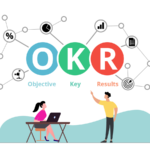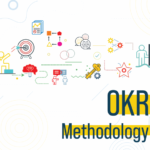
In his book ‘Measure What Matters’, John Doerr, the father of OKR, mentioned, “An effective goal-setting system starts with disciplined thinking at the top, with leaders who invest the time and energy to choose what counts.”
To simplify, OKR known as Objectives and Key Results is a process of setting goal that connects the company, team, and goals to generate measurable metrics, enabling the marketing department to work in a unified direction to achieve the long-term global goal. Because, marketing is not just about repeating the number of leads, views, clicks, etc., that you need each month. It is about figuring out what you can do better every day and where you need to focus.
Why are Marketing OKRs important?
Every organization’s marketing department plays a vital role in promoting the company. They coordinate and create all the marketing materials like brochures, collaterals, e-books, etc., to keep up the company’s image and help attract prospects, consumers, investors, and the audience’s attention, creating a global image that showcases your company in a positive light.
The goal-setting method clarifies the team members on how to optimize their daily efforts in strengthening the brand name, generating quality leads for sales, or building marketing capability by using both digital and traditional marketing. Thus, with well-defined marketing OKRS, team members can connect to the bigger picture of the entire organization and strive for more success.
OKR Examples for Marketing Team – Guide to OKRs
We have listed a few examples below to inspire you to set an OKR for your marketing team –
Inbound Marketing OKR Examples
#1 Objective – Increase the number of new inbound qualified leads.
- Key Result 1: Increase demo requests via the PPC (pay-per-click) landing pages by 20% before [date].
- Key Result 2 : Increase the lead conversion rate from 5% to 15% through webinar attendees by [date].
- Key Result 3: Increase the download rate of eBooks by 2x over last month before the end of Q2.
#2 Objective: Set up a new inbound campaign.
- Key Result 1: Increase the number of monthly visitors from 30,000 to 600,000 by the end of Q2.
- Key Result 2: Raise the DA (Domain Authority) rating from 40 to 70 by [date].
- Key Result 3: Increase on-site visitor to trial conversion rate from 5% to 10% by [month].
Product Marketing OKR Examples
#1 Objective: Gather customer feedback on our existing product in the market.
- Key Result 1: Conduct 30 customer interviews to identify why they bought our product and how was the after-use experience by [date].
- Key Result 2: Capture 1,000 responses through an online survey about our product positioning before the [month].
- Key Result 3: Identify the topmost prevalent obstacles to increase sales per customer before [date].
#2 Objective: Introduce new products to the market by a well-written crisp marketing message.
- Key Result 1: Conduct a user test session with 25 customers to test the new product by [date].
- Key Result 2: During the product launch, choose five different channels to help you run your product ads by [date].
- Key Result 3: Provide a free trial to 15 customer groups to showcase your product offering before [date].
Content Marketing OKR Examples
#1 Objective: Improve the content strategy.
- Key Result 1: Publish 5 monthly articles with proper keywords and more than 1,000 words each by [month].
- Key Result 2: Identify 5 new channels/forums or communities to post our content by [date].
- Key Result 3: Grow the blog subscriber count from 6,000 to 12,000 by the end of Q2.
#2 Objective: Decrease the bounce rate on all the published blogs.
- Key Result 1: Include at least one video or infographic image on our top bounce rate pages [mention the date].
- Key Result 2: Include 2-3 relevant internal links on all the published blogs/articles by [date].
- Key Result 3: Reduce page loading time from 30 seconds to 12 seconds before [date].
Social Media Marketing OKR Examples
#1 Objective: Improve the brand presence and engagement in Social Networks.
- Key Result 1: Use direct messaging to find and engage with 50 thought leaders by the end of Q2.
- Key Result 2: Increase followers on all our social media platforms (Facebook/ Instagram/LinkedIn/YouTube) by 10% per month till the end of Q2.
- Key Result 2: Start posting four times a day on different social media platforms to increase visibility by [date].
#2 Objective: Boost paid users from social media.
- Key Result 1: Raise website visitors from social media by 25% each month till the last month of Q2.
- Key Result 2: Increase Signups from social media by 15% every month by the end of Q2.
- Key Result 3: Increase demo requests from social media from 10% to 20% each month before [date].
SEO (Search Engine Optimization) OKR Examples
#1 Objective: Become a prominent player on Google search.
- Key Result 1: Identify the top 5 keywords and improve the SEO of already published articles by [date].
- Key Result 2: Appear on the first page of the search -engine for the top 5 keywords within a maximum of 1 month.
- Key Result 3: Get 80 backlinks each for the SEO content on the targeted keywords per month.
#2 Objective: Improve ranking on top 3 untapped relevant keywords.
- Key Result 1: Identify 30 relevant keywords that are untapped by competitors by [date].
- Key Result 2: Create a CMS (Content Management System) template for the blog page to manage and modify the content before the end of [month].
- Key Result 3: Build long-form content and post it on multiple pages using the CMS template by [date].
Brand Marketing OKR Examples
#1 Objective: Establish a strong brand presence.
- Key Result 1: Have 2 publications with influencers per week before [month].
- Key Result 2: Conduct campaigns with the top 5 industry influencers by [date].
- Key Result 3: Achieve 4 out of 5-star ratings and 250 positive reviews on Google before [date].
#2 Objective: Increase brand communication.
- Key result 1: Expand the community members from 15,000 to 30,000 by the end of [date].
- Key result 2: Decrease response time from 30 minutes to 10 minutes by [date].
- Key result 3: Increase customer satisfaction (CSAT) from 50% to 100% by the end of Q2.
PPC (Pay-Per-Click) Marketing OKR Examples
#1 Objective: Increase the outcomes of Ad campaigns.
- Key result 1: Increase the average CTR (Click-through rate) of ad campaigns from 1% to 5% by [date].
- Key result 2: Increase the lead conversion rate for paid traffic from 3% to 15% by [date].
To conclude, one mantra to set winning OKRs is when you are drafting an objective, first define a problem you want to solve, then try to phrase your key results with the highest impact.
Breaking down larger tasks is highly beneficial for your team. It makes actions manageable and boosts employees’ confidence. They will perceive that they are contributing to a larger goal and feel more motivated to achieve the key results to make the company successful.

